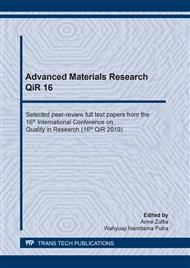p.324
p.331
p.339
p.348
p.356
p.364
p.375
p.381
p.391
Optimization of Gas Metal Arc Welding (GMAW) Parameters for Minimum Distortion of T Welded Joints of A36 Mild Steel by Taguchi Method
Abstract:
In this study, the GMAW parameters for welding of A36 mild steel have been investigated to get the minimum of distortion. The type of welded joint used was square groove T-joint fillet weld with filler wire ER70S-6. The welding current and the welding speed were selected as input parameters while the response used was distortion (longitudinal bending distortion and angular distortion). Taguchi method was used to determine optimal welding parameters which the minimum distortion. Design of experiment was set two factors with three level in each factor and three replication, so the L9 Taguchi’s orthogonal array was applied. The minimum conditions were determined using S/N ratio with a quality character of smaller is better (SB). In addition, to determine the significance of the welding parameters used ANOVA. The results show that the welding current of 170 A and the welding speed of 4.0 mm/s were obtained as the minimum of longitudinal bending distortion and angular distortion. Based on analysis of variance, the welding current was a parameter that greatly affects the longitudinal bending distortion with the percentage contribution of 64.36% while angular distortion was strongly influenced by welding speed parameter with the percentage contribution of 53.38%.
Info:
Periodical:
Pages:
356-363
Citation:
Online since:
July 2020
Keywords:
Price:
Сopyright:
© 2020 Trans Tech Publications Ltd. All Rights Reserved
Share:
Citation:


